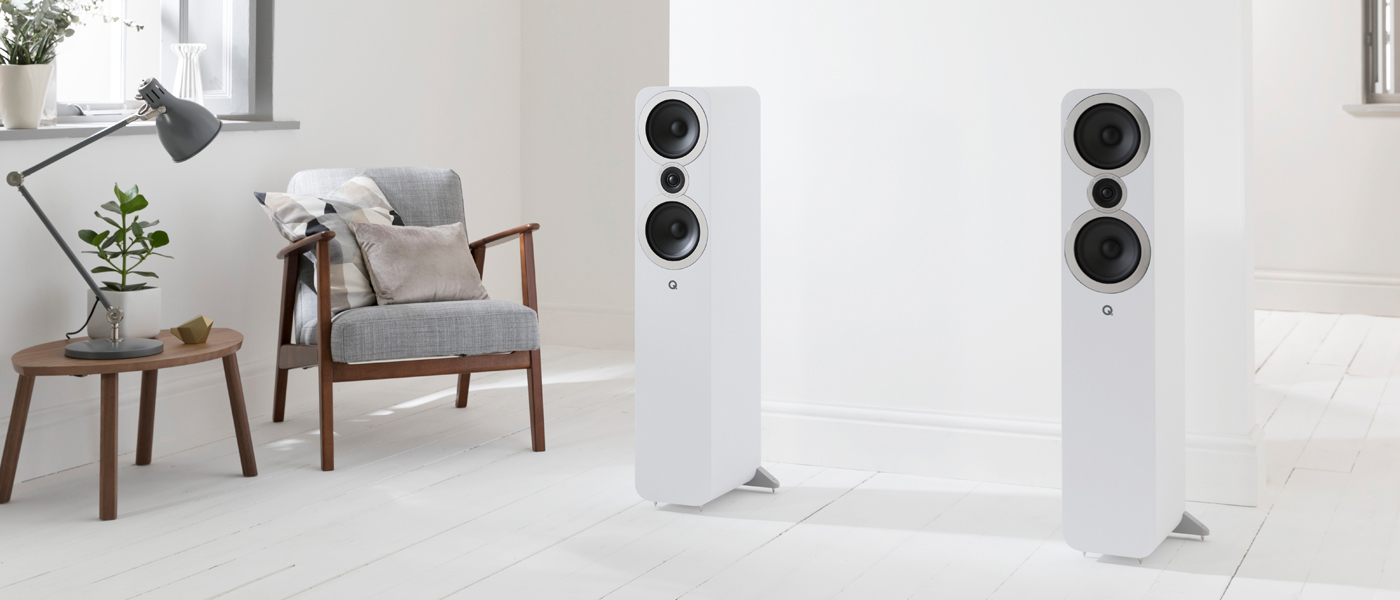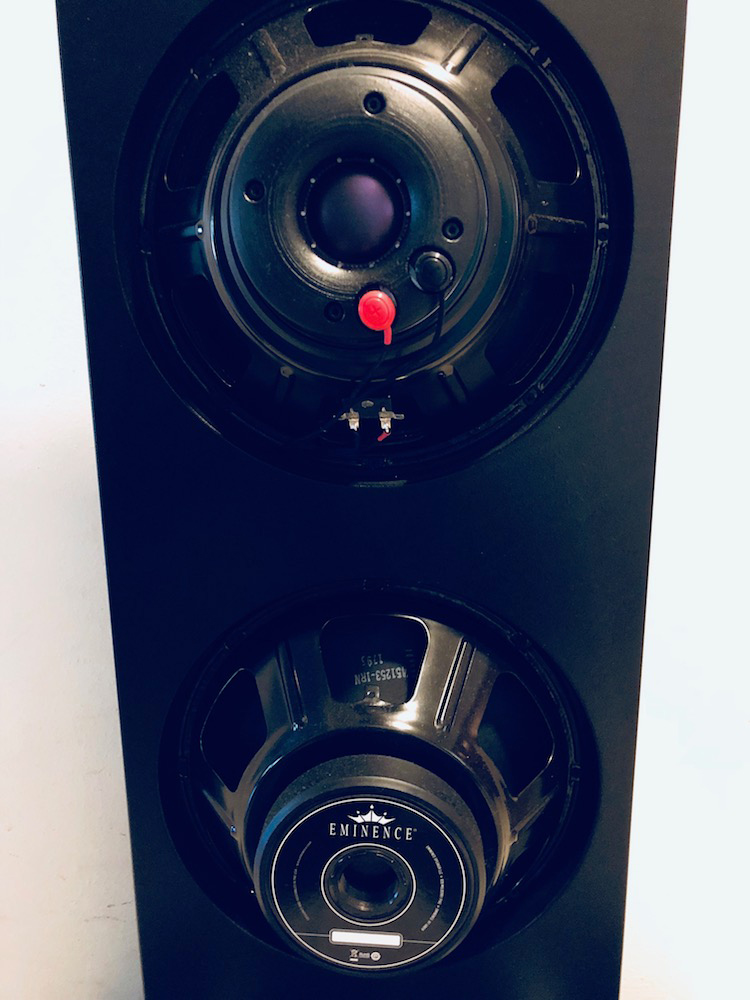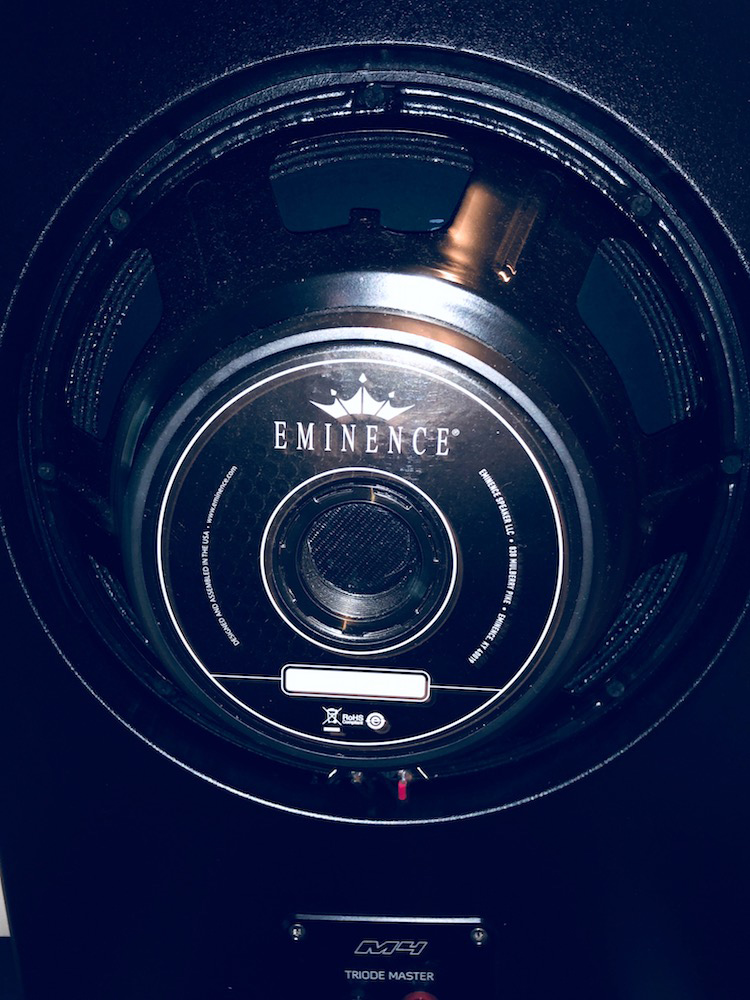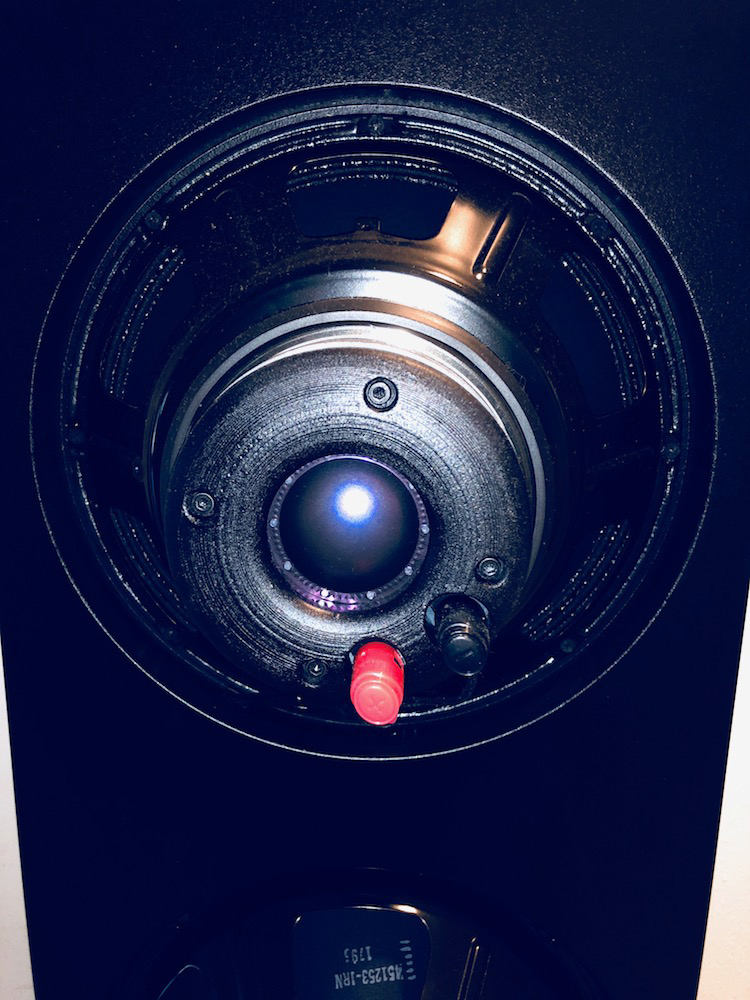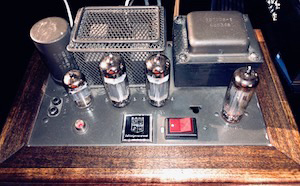
Spatial Audio M4 Triode Master speakers
- One twelve-inch midrange/woofer driver and one twelve-inch wide-bandwidth M35 Dipolar Compression driver
- 93db sensitivity
- 12-ohm average impedance
- Minimum power requirement is 10w tube or solid-state amplifier
- Available in black, red, or white finishes, and easy integrate into your listening room’s décor
- Made in USA with 20-year limited warranty
- Excellent customer support
- Sixty-day trial period with no-hassle return guarantee
Spatial Audio owner and designer Clayton Shaw wants to enable music fans to experience top-dollar sound without having to pay top-dollar prices, and his line of open-baffle speakers goes a very long way toward satisfying that desire. But these elegant, minimal, and open-baffle speakers are sure to, well, baffle those who think a loudspeaker system should be in an enclosed container – the Spatial speakers are essentially two drivers mounted into massive slabs of two-layer high-density fiberboard with their baskets and magnets exposed to the rear.
DESIGN:
Precision Point Source 2-way coaxial design, open-baffle, dynamic driver, controlled directivity, low noise design
SENSITIVITY:
93dB averaged across 200Hz to 5kHz at 1M on axis
MFR:
40Hz – 22kHz +/- 3dB in-room response
DRIVERS:
One twelve-inch midrange/woofer driver and one twelve-inch wide-bandwidth M35 Dipolar Compression driver
CROSSOVER:
800Hz – Passive – Hologram Passive Network Technology
IMPEDENCE:
12-ohm average
INPUTS:
WBT NextGen Binding Posts
WEIGHT:
44 lbs. (20 kg)
DIMENSIONS:
36 inches (92cm) x 14 inches (35cm) x 3 inches (8cm)
AVAILABLE FINISHES:
Black, red, or white
MSRP (PAIR):
$2995
Company:
SECRETS Tags:
Spatial, M4, Triode Master, floorstanding speaker, open-baffle, floorstanding Speaker Reviews 2018
Spatial’s M3 and M4 lines of speakers are each available in several different configurations, with increasing prices buying you better capacitors, drivers, and wiring. And if you buy a pair with a lower-level configuration, chances are very good that you can send them to Spatial for upgrades. Other than the single-panel M Force bass system at $1295, the M4s are the least expensive of Spatial’s line. The base M4 model, the Turbo S, sells for $1995 per pair. The pair that I am reviewing are in the M4 Triode Master configuration and sell for $2995.
Secrets Sponsor
Now, let’s talk about trim levels. $1995 will get you a pair of Spatial M4 speakers in their introductory trim level, the Turbo S. Now that is a very good price for a pair of starter speakers that punch way outside of their weight level. But if you buy a pair of M4 Turbo S speakers and decide you want them upgraded to Triode Master level, you send Clayton Shaw $895. He’ll send you a new shipping box, and you send the speakers to him. When he has them back in his facility, he’ll replace the compression driver with the M35 Uniwave driver, install Duelund cabling, and replace the electrical section with the Triode Master crossover, which utilizes beefier Clarity Cap capacitors.
The sensitivity of the speakers will remain the same, at 93db, but you’ll see an improvement in impedance to 12 ohms average. Your frequency response range will increase from 45Hz to 20kHz, to 40Hz to 22kHz. And your improved crossover range will shift from 700Hz to 800Hz to get the most out of the new drivers. So your upgraded M4s will go higher and lower and bring more boogie.
Shaw offers his speakers with a sixty-day trial period and a no-hassle return guarantee. Call him up, order a pair, and if you don’t like them, just send them back within sixty days (you’ll have to cover the return postage). You may have to wait a few weeks for delivery, however; all of Spatial’s speakers are built by hand in their factory in Salt Lake City, Utah, and demand is strong. I think you’ll understand why as soon as you hear a pair of his speakers. Shaw recently made a big splash at RMAF with his new Lumina L2 line powered with Vinni Rossi electronics and stitched together with Anticables, and he is well on his way to bigger and better things.
So if you’re on the fence about purchasing something from him, just contact Clayton Shaw at Spatial Audio and he’ll help you out.
The Spatial M4 Triode Masters are 93db efficient with a 12-ohm average impedance. These numbers promise a happy partnership with both low-watt and high-watt amplifiers. But do they deliver on that promise? Will they sing or slouch with a 2.5-watt single-ended triode amp? Will they soar or start smoking with a 150-watt Class-D amp? Well, I set out to answer those questions as I put the M4 Triode Masters to the tests.
“Lose the box.” That’s the challenge that Clayton Shaw – the owner and proprietor of Spatial Audio – has set out to meet. And meet it he has. Visit the company’s website and you’ll see that not a single one of his several lines of speakers is built in a box. Each Spatial speaker features a driver or drivers mounted into a flat panel (or panels, as in the Spatial X2 series). Some of these panels are made of fiberboard, such as two-layer HDF (high density fiberboard) for the starter M4 line, up to exotic wood such as solid Baltic Birch for the more expensive X2 line. But each panel’s simplicity belies its simple and undeniable attractiveness. The paint or wood finishes, whether industrial black or natural wood grain, are consistently gorgeous and easy to look at. Their form perfectly complements their function. Much like the designs of De Stijl architects such as Theo von Doesburg or painters such as Piet Mondriaan, who portrayed strength, simplicity, and sheer presence with simple fields of colors, Shaw’s speakers recall the elegance of those artists. They do not call much attention to themselves visually (and sonically they just plain disappear), but when you look at them, or notice how they interact with the other objects in their vicinity (such as your listening room, home theater, or wherever), they portray a refreshing simplicity. And because they’re not solid boxes, they use up less volume and seem less visually oppressive, like many box speakers do.
One panel, two drivers, and all of the music. And magnets. How do they work? How did Clayton Shaw get two drivers to produce a frequency response of 40Hz to 22kHz with such coherence? Full details here.
The Spatial line of speakers may look like they are simply drivers screwed into planks, but that is far from their true nature. The open-baffle design eliminates all manner of box-related resonances and re-radiation of sound from inside of the box. This enables the drivers to make music with free-flowing ease and dimensionality that sounds more like live music and less like hi-fi reproduction. The bass is extremely detailed and realistic sounding and the midrange is portrayed naturally, with an open, 3D presentation. And the drivers are more sensitive because there’s no box around them to, well, box them in.
The point source drivers provide a coherent transition from midrange to treble and imaging by eliminating comb-filtering, which is the interference patterns found when the tweeter is physically separate, as in most speaker designs. The Spatial speakers exhibit phenomenal imaging and soundstaging. The dispersion angle of the drivers is limited to around 80 degrees and held constant across the spectrum, which allows less interaction with the room and much more even response in reflected field energy. And greater focus means greater soundstaging.
The M4s utilize two custom Eminence drivers developed for Clayton Shaw to meet his specifications. Shaw knows that uniform frequency response is critical to accurate music reproduction, so great care has been taken in voicing the speaker to reproduce natural pitch and tonal balance. The use of very high-efficiency drivers provides outstanding dynamic response without compression effects. The midrange/tweeter driver’s 108dB sensitivity essentially eliminates any compression distortion when used in domestic applications. The ultra-wideband suspension design of the compression drivers allows a very low crossover point at 700Hz, which provides coherent, high-definition sound reproduction through the midrange and treble regions. Because most of the midrange is produced by the low-mass compression driver instead of the cone driver, a dramatic improvement in resolution and reduced distortion is provided compared to conventional speaker designs.
You connect your speaker cables into substantial five-way WBT NextGen binding posts which readily accept banana plugs, bare wire, or spades. And there’s only one pair; the M4s are not meant to be bi-wired or bi-amped.
The speakers arrived very well packed in separate boxes. Some assembly was required but it was quite easy; use the included hex wrenches to attach the two aluminum strips to the bottom of each speaker with hex screws. Spatial includes two types of footers for the speakers: hard plastic domes and metal spikes, for those putting the speakers on carpet. And each footer can be adjusted to keep the speakers level.
I’m not going to lie. The M4s sounded amazing as soon as I powered them up the first time. My primary loudspeakers for the last fifteen years have been a pair of 1977 Klipsch Cornwalls. The Cornwalls have fresh tweeter diaphragms and crossovers, and internal solid-core copper wiring. They’ve also been dampened and tightened up about as much as possible with their default configuration, and sound pretty darn good for what I paid for them. Their legendary high efficiency makes them easy to drive with a wide variety of amplifiers, and they are a friendly speaker that easily get one’s toes tapping. But they have their shortcomings, and I’ve been well aware of those after fifteen years of critical listening. One quirk of the Cornwalls I could never get past is their lack of coherence across their drivers; I could always hear how a note would suffer when its frequencies had to travel from the midrange to the tweeter, for example, which, of course, disturbs the flow of the music.
Which is why I was so instantly enamored by the M4s’ coherence. There is absolutely no “seam” in the frequencies produced by the drivers, so there’s nothing to disturb a note’s flow. And with this coherence the M4s can more accurately and consistently portray a soundstage, a rim shot on a snare drum, a blue note from a trumpet, a thumb thump on a bass fiddle’s G string, and the air around an acoustic instrument or microphone as a note floats through air and decays. Granted, I’ve heard this quality in $40,000 speakers, but it’s a treat to hear it in a speaker of this price range.
My listening room is 13 feet long, 12 feet wide and has 8-foot tall ceilings. On both sides of the room is a walkway; the one on the left is in the shape of a door, and the one on the right is in the shape of an arch and is bigger than the door. This irregularity presents particular challenges with speaker placement; the bigger opening on the right causes an imbalance in the amount of wall space a speaker in that corner has to reflect soundwaves. Depending on the amplifier I’m using, I occasionally have to send more power to the right channel to get a correct sound energy balance in my listening spot, which is about twelve feet away from the speakers.
Shaw provides a very clear and informative PDF user manual for the speakers. He recommends that the M4 line be used in rooms less than twelve feet wide, and the M3 line for larger rooms. Even though my room is slightly larger than what he recommends for the M4s, I could find no inadequacies with them. Shaw’s recommended placement for the speakers is one foot or more away from the side wall, and three feet away from the wall behind the speaker. Of course, if you have any questions, you can just get him on the phone and he’ll help you make the best purchase decision for your room.
That said, their dipole nature made the M4s surprisingly easy to place in the listening room. I corner-loaded them, with about three feet between the back of the M4s and the back wall, and the side wall about two feet away from the sides of the M4s. Set up like that, they disappeared quite easily while playing music as I sat in my sweet spot. Moving them around a bit while they were running with high-powered amplifiers made very little difference to the speakers’ ability to image and disappear.
Shaw told me that he has recorded a 6db increase in bass output after the speakers are given over one hundred hours of break-in time. The scuttlebutt on the Internet forums about the Spatial line is that they really like two hundred hours of high volume to really break them in. Doing this is not possible with my living situation; but my primary system doubles as my home theater system and the M4s got a good ten hours per day of movies, music, television, and video games. After about two hundred hours of break in, I definitely heard improvement across the board, particularly with soundstaging. The bass had definitely tightened up which helped define the location of instruments in the soundstage.
For quite some time I have been trying to find a pair of floorstanding speakers to replace my Cornwalls in the $2,000US to $3,000US price range, and have been unable to find anything that really stirred my soul. That’s not for lack of trying; I’ve been auditioning speakers in local shops (and at RMAF) for quite some time. I knew I had found what I’ve been looking for as soon as I powered up the Spatials. When I had them in my house, I set out to test them with a variety of amplifiers. Here’s what I found.
Just ten watts, huh? According to the speakers’ specifications, amplifier requirements are “tube or solid state 10W or larger,” with a 93dB sensitivity at a 12-ohm average impedance, with a 3-ohm minimum. Clayton Shaw says that the nominal impedance is around 12 ohms and the curve is quite linear, so it indicates low reactance.
That’s quite a promise. I put it to the test with a wide variety of amplifiers. I tried three types of amplifiers: a 2.5w single-ended triode (SET) tube amp, a pair of 30w push-pull tube amps, a 50w mid-1970s solid state amp, and a 150w Class-D amp.
With the McIntosh MC2505 amplifier. This is McIntosh solid-state power circa 1977. Big fat transformers provide a fair amount of grunt, and 0.25% THD while pushing 50w whether it sees a 4-, 8-, or 16-ohm load. My unit has been given a thorough refurbishment recently, with fresh caps and resistors, and it’s sounding as good as it should. It is an exceedingly non-fatiguing and easy to listen to amplifier, which is why it is my primary amplifier. I just keep it plugged in all the time, and can listen to it for hours on end with no fatigue at all. And even though it is solid state, it does possess a good bit of that magical, lit-from-within midrange for which the earlier McIntosh tube amplifiers are respected.
Powered by this amp, the Spatials also were easy to listen to for hours on end. The MC2505’s 50 watts was more than enough to get the M4s to throw a very convincing and wide soundstage, with noticeable back-to-front imaging as well. While not providing the finest details with regard to note decay, the amp was still fast enough to portray a reasonably good representation of the 3D soundstage when driving the Spatials.
With the McIntosh MC30 amplifiers. I am fortunate enough to own a pair of what many consider to be one of McIntosh’s best tube amps: the MC30. Push-pull amps with tube rectification, massive transformers, 6L6 power tubes, and point-to-point wiring, these things are built like a tank, and built to last. My pair was given a complete restoration recently, so I know they’re operating in best possible condition.
The M4s maintained their disappearing act with the MC30s, and produced a warm and lit-from-within sound. While the bass didn’t have the etched quality I heard with the Class-D amplifier (see below), it was nonetheless there and prodigious. Although the MC30s will only put out 30 to 40w at 4ohm, they keep plenty of voltage on tap in their giant transformers and will move a speaker’s drivers when the music calls for it. The Spatial’s ability to portray dramatic shifts in volume or tone did not suffer when powered by the MC30s.
With the SET amp. You know the type. There’s at least one in every local hifi enthusiast group: the SET Enthusiast. The dyed-in-the-wool Flat Earther. He likes single-driver speakers with exotic drivers from Lowther or Altec-Lansing in ported boxes. He likes horn drivers. And he really likes very big and expensive tubes, like the 2A3 and 300B. That’s a lifestyle choice, and I accept it. And I’ll admit that I have ascribed to many of those beliefs, or that I used to, before I heard the Spatials.
I borrowed a home-brew SET amp from a local enthusiast. This thing uses a pair of EL84 tubes to output a whopping 2.5 watts. (Side point: who measures, let alone believes, that half a watt is important? Beats me.) I put it in the system by running it through my McIntosh C28 preamp, ran some speaker cables, and turned it on. After a few minutes to enable it to warm up and saturate its transformers, I played some music. So how’d that work out for me and the M4s?
Much, much better than I had anticipated. Even though the volume knob of the C28 preamp was at the 4 o’clock position, there was no buzz or hum coming out of the Spatials. I like to listen to verbal cues like the air around a singer – or the ability to hear the sound partitions around a singer – as evidence of low-level detail retrieval.
Listening to Karen Carpenter’s voice in “Crescent Noon,” I could hear how her vocal chords excited the air around her and bounced off the partitions. These were not details I had expected the Spatials to portray with a tiny 2.5w of power driving them. But they did it. Karen’s image and voice appeared clearly between the two speakers, which did not falter when she dove into the low notes. The sound of her brother Richard’s piano was portrayed with excellent timbre accuracy and energy, but with that midrange flow so adored by SET enthusiasts. I could well hear the woodiness of the strings and the brassiness of the horns. And I was sitting about twelve feet away from the M4s.
I did not get the impression that the Spatials were starving of power to make the music; it flowed easily. While the SET amp did not have the tightest control on the lowest frequencies, as one would expect, the timbre and imaging of the bass guitar and low notes was still accurate. That the M4s were still able to maintain their seamlessness and imaging with such a low-power amplifier is quite impressive.
And while listening with this flea-watt powered amp, I heard things *behind* me. I guess this is what they refer to as “holographic imaging.” The Spatials portrayed the usual soundstage in front of me with this amp, but I heard spatial cues occurring in the soundstage behind me as well – I heard what I thought was echoes of sound against a wall or sound partition in what is really my front yard. It took me by surprise. And, for the record, this was the only amp that pulled that off with the Spatials. Neat.
With the Class-D amplifier. I borrowed a Class-D amp built by another local enthusiast based on the Class-D Audio CDA-250C kit. This amp will output 150w into 8 ohms. Powered by this amp, the Spatials portrayed instruments with much more finely-etched detail. The low-level detail – decay of cymbals, separation between notes – increased exponentially. The speakers disappeared completely (as they always did with the other amps), and the soundstage replaced my listening room. I heard much deeper into the notes of the recordings and could see sounds swirling on the soundstage squarely three feet above my head. It was quite a thrill.
I have little experience or time with Class-D amps, but have been reading about them with great interest recently. What intrigues me about them in particular is their supposed ability to provide a very low noise floor with high power at relatively affordable prices. While I enjoy my vintage amps from the 1960s and 1970s, high power and very low noise floors are not their strong suits, so what you lose in low-level musical detail retrieval you make up with tactility and warmth. It’s a trade-off many of us not-so-wealthy audio nuts make frequently.
Secrets Sponsor
But the challenge for me is that low-level detail is very important to me, and the more of it I can get out of my system, the better. The Spatials showed me more low-level detail with the Class-D amp without getting fatiguing. Granted, it took me some time to adjust my hearing, or readjust my expectations, with the Class-D amp, but when I had done that, and when that amp had warmed up, the music flowed with plenty of drive and no friction. And this is a situation I could easily get used to.
The Spatial M4 Triode Master speakers deliver much more good sound, and do so more easily, than you would expect for their $2995 price tag. As the top trim level of the introductory M4 line, I’m fairly certain that the M4 Turbo S speakers, at $1995 a pair, are a no brainer way to get good sound into your life. If you can swing the extra $1000, you should definitely consider the M4 Triode Masters.
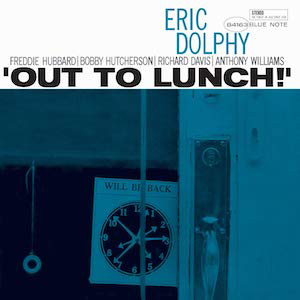
Recorded by Rudy Van Gelder in his Englewood Cliffs studio for Blue Note records in 1964, this is a challenging and surprising jazz session that very well captures the avant-garde ideas of the 1960s. As with many RVG recordings, it has an open sound with great placement of instruments in the soundstage and startling dynamics.
It also has quite a few sounds you don’t normally hear come out of familiar instruments; the “ponk! ponk!” tones Bobby Hutcherson beats out of his vibraphone always brings a smile to my face. With the tube amps, the wooden and metal timbres of the acoustic instruments was quite accurate and warm, with the M4s very well portraying the brassy blatting of Freddie Hubbard’s trumpet and honking of Eric Dolphy’s clarinet and alto saxophone. With the Class-D amp, it was much easier to see each instrument in the soundstage and to hear the air around each instrument. Tony Williams’ drums in particular became much easier to visualize with the lower noise floor; the interior echo of floor toms and sounds of individual metal hairs of his brushes on the snare drums in particular were easier to distinguish.
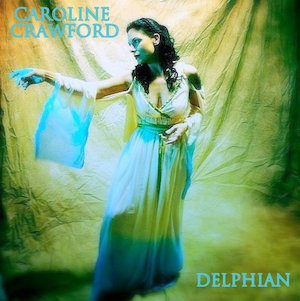
Recorded in two days in a small studio in Mississippi, Crawford’s debut album is one I frequently use to test systems. Her classically-trained voice is recorded close to the microphone, and the sounds of her grand piano bounce off the partitions of the recording room. A good system will enable me to easily distinguish between the decay of the notes of her voice and those of the piano, and the Spatial M4s did not let me down.
With the tube amps Crawford’s voice was more lit from within; her timbre remaining accurate as she sang loudly or softly. With the Class-D amp, the brassy decay of her drummer’s cymbals became more delicate and easy to distinguish. The engineer for the session used several microphones on the piano to capture the sound of the action, such as the pedals creaking and the hammers hitting the strings, and this became much more apparent with the Class-D amp. Crawford’s voice has a very wide range, and hearing her carry a note from a low register to a high one without any loss of timing or integrity is one of the things that make the Spatial M4s so special to me.
THE SPATIAL AUDIO M4 TRIODE MASTER SPEAKERS deliver accurate sound from four efficient drivers mounted in a panel for relatively little money. Affordable speakers and highly recommended.
- Very easy to power with a wide variety of amplifiers
- Excellent customer service and money-back guarantee
- They provide clarity, dynamics, and transparency that belies their $2995 price
- Nothing, really
I could not make these speakers sound bad. With two watts or two hundred, they made engaging music and completely disappeared in my room. They’re sturdy, attractive, and backed by honest customer support. The only danger here is that you’ll eventually want to spend more money on Spatial’s more expensive speakers.


